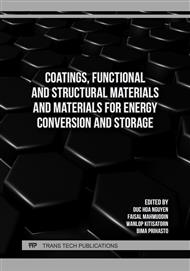[1]
J. Liu, M.Y. Yu, Z.Z. Yu and V. Nicolosi, Design and advanced manufacturing of electromagnetic interference shielding materials, Mater. Today. 66 (2023) 245-272.
DOI: 10.1016/j.mattod.2023.03.022
Google Scholar
[2]
H. Pang, Y. Duan, L. Huang, L. Song, J. Liu, T. Zhang, X. Yang, J. Liu, X. Ma, J. Di, X. Liu, Research advances in composition, structure and mechanisms of microwave absorbing materials, Compos. B. Eng. 224 (2021) 109173.
DOI: 10.1016/j.compositesb.2021.109173
Google Scholar
[3]
T.Q. Dat, N.T. Ha, D.Q. Hung, Reduced graphene oxide-Cu0.5Ni0.5Fe2O4-polyaniline nanocomposite: preparation, characterization and microwave absorption properties, J. Electron. Mater. 46 (2017) 3707-3713.
DOI: 10.1007/s11664-017-5386-z
Google Scholar
[4]
P.T. Tho, C.T.A. Xuan, N. Tran, N.Q. Tuan, W.H. Jeong, S.W. Kim, T.Q. Dat, V.D. Nguyen. T.N. Bach, T.D. Thanh, D.T. Khan and B.W. Lee, Ultra-wide effective absorption bandwidth of Cu, Co, and Ti co-doped SrFe12O19 hexaferrite, Ceram. Int. 48 (19) (2022) 27409-27419.
DOI: 10.1016/j.ceramint.2022.05.389
Google Scholar
[5]
C.T.A. Xuan, P.T. Tho, T.Q. Dat, N.V. Khien, T.N. Bach, N.T.M. Hong, T.A. Ho, D.T. Khan, H.N. Toan and N. Tran, Development of high-efficiency microwave absorption properties of La1.5Sr0.5NiO4 and SrFe12O19-based materials composites, Surf. Interfaces. 39 (2023) 102890.
DOI: 10.1016/j.surfin.2023.102890
Google Scholar
[6]
Q. Zhu, X. Luo, H. Li, J. Zang, J. Sun, X. Yan and Y. Liu, Construction and boosted electromagnetic wave absorption performance of porous aggregates of multi-element doped Fe₃O₄/(Fe, Co, Ni, Cu) alloy with magnetic/magnetic heterostructure, J. Magn. Magn. Mater. 588 (2023) 171432.
DOI: 10.1016/j.jmmm.2023.171432
Google Scholar
[7]
Y. Lu, X. Zhao, Q. Tian, Y. Lin, P. Li, Y. Tao, Z. Wang, J. Ma, H. Xu and Y. Liu, Hierarchical porous biomass-derived carbon with rich nitrogen doping for high-performance microwave absorption and tensile strain sensing, Carbon 224 (2024) 119083.
DOI: 10.1016/j.carbon.2024.119083
Google Scholar
[8]
J. Ma, H. Ren, X. Zhang, Z. Liu, S. Wang, W. Lian, C. Li, Y. Liu and L. Kong, Multilayer rose-like CoS₂-MoS₂ composites with high microwave absorption performance, J. Magn. Magn. Mater. 568 (2023) 170390.
DOI: 10.1016/j.jmmm.2023.170390
Google Scholar
[9]
H. Zhang, Q. Ding, G. Zhao and J. Song, Synthesis of NiCo₂O₄/CF composites with heterogeneous interfaces as excellent microwave absorbers, Mater. Today Commun. 37 (2023) 106919.
DOI: 10.1016/j.mtcomm.2023.106919
Google Scholar
[10]
H.J. Oh, V.D. Dao and H.S. Choi, Electromagnetic shielding effectiveness of a thin silver layer deposited onto PET film via atmospheric pressure plasma reduction, Appl. Surf. Sci. 435 (2018) 7-15.
DOI: 10.1016/j.apsusc.2017.11.043
Google Scholar
[11]
[X. Chen, H. Liu, D. Hu, H. Liu, W. Ma, Recent advances in carbon nanotubes-based microwave absorbing composites, Ceram. Int. 47 (2021) 23749-23761.
DOI: 10.1016/j.ceramint.2021.05.219
Google Scholar
[12]
R. Qiang, S. Feng, Y. Chen, Q. Ma and B. Chen, Recent progress in biomass-derived carbonaceous composites for enhanced microwave absorption, J. Colloid Interface Sci. 606 (1) (2022) 406-423.
DOI: 10.1016/j.jcis.2021.07.144
Google Scholar
[13]
H. Guan, Q. Wang, X. Wu, J. Pang, Z. Jiang, G. Chen, C. Dong, L. Wang and C. Gong, Biomass derived porous carbon (BPC) and their composites as lightweight and efficient microwave absorption materials, Compos. B. Eng. 207 (2021) 108562.
DOI: 10.1016/j.compositesb.2020.108562
Google Scholar
[14]
R. Peymanfar and A. Ali Mirkhan, Biomass-derived materials: Promising, affordable, capable, simple, and lightweight microwave absorbing structures, J. Chem. Eng. 446 (1) (2022) 136903.
DOI: 10.1016/j.cej.2022.136903
Google Scholar
[15]
Z. Wu, Z. Meng, C. Yao, Y. Deang, G. Zhang and Y. Wang, Rice husk derived hierarchical porous carbon with lightweight and efficient microwave absorption, Mater. Chem. Phys. 275 (2022) 125246.
DOI: 10.1016/j.matchemphys.2021.125246
Google Scholar
[16]
Q. Li, J. Zhu, S. Wang, F. Huang, Q. Liu and X. Kong, Microwave absorption on a bare biomass derived holey silica-hybridized carbon absorbent, Carbon 161 (2020) 639-646.
DOI: 10.1016/j.carbon.2020.01.087
Google Scholar
[17]
X. Fang, W. Li, X. Chen, Z. Wu, Z. Zhang and Y. Zou, Controlling the microstructure of biomass-derived porous carbon to assemble structural absorber for broadening bandwidth, Carbon 198 (2022) 70-79.
DOI: 10.1016/j.carbon.2022.06.074
Google Scholar
[18]
Q. Yang, Y. Gao, T. Li, L. Ma, Q. Qi, T. Yang and F. Meng, Advances in carbon fiber-based electromagnetic shielding materials: Composition, structure, and application, Carbon 226 (2024) 119203.
DOI: 10.1016/j.carbon.2024.119203
Google Scholar
[19]
J. Xi, E. Zhou, Y. Liu, W. Gao, J. Ying, Z. Chen Z and C. Gao, Wood-based straightway channel structure for high performance microwave absorption, Carbon 124 (2017) 492-498.
DOI: 10.1016/j.carbon.2017.07.088
Google Scholar
[20]
N. Wang, F. Wu, A. Xie, X. Dai, M. Sun, Y. Qiu, Y. Wang, X. Lv and M. Wang, One-pot synthesis of biomass-derived carbonaceous spheres for excellent microwave absorption at the Ku band, RSC Adv. 5 (2015) 40531-40535.
DOI: 10.1039/c5ra06307h
Google Scholar
[21]
H. Zhao, Y. Cheng, H. Lv, B. Zhang, G. Ji and Y. Du, Achieving sustainable ultralight electromagnetic absorber from flour by turning surface morphology of nanoporous carbon, ACS Sustainable Chem. Eng. 6 (11) (2018) 15850-15857.
DOI: 10.1021/acssuschemeng.8b04461
Google Scholar
[22]
H. Liu, S. Wu, C. You, N. Tian, Y. Li and N. Chopra, Recent progress in morphological engineering of carbon materials for electromagnetic interference shielding, Carbon 172 (2021) 569-596.
DOI: 10.1016/j.carbon.2020.10.067
Google Scholar
[23]
T. Chen, J. Cai, D. Gong, C. Liu, P. Liu, X. Cheng and D. Zhang, Facile fabrication of 3D biochar absorbers dual-loaded with Fe₃O₄ nanoparticles for enhanced microwave absorption, J. Alloys Compd. 935 (1) (2023) 168085.
DOI: 10.1016/j.jallcom.2022.168085
Google Scholar
[24]
J. Wang, M. Zhou, Z. Xie, X. Hao, S. Tang, J. Wang, Z. Zou and G. Ji, Enhanced interfacial polarization of biomass-derived porous carbon with a low radar cross-section, J. Colloid Interface Sci. 612 (2022) 146-155.
DOI: 10.1016/j.jcis.2021.12.162
Google Scholar



